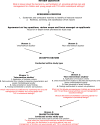An ongoing struggle: a mixed-method systematic review of interventions, barriers and facilitators to achieving optimal self-care by children and young people with type 1 diabetes in educational settings
- PMID: 25213220
- PMCID: PMC4263204
- DOI: 10.1186/1471-2431-14-228
An ongoing struggle: a mixed-method systematic review of interventions, barriers and facilitators to achieving optimal self-care by children and young people with type 1 diabetes in educational settings
Abstract
Background: Type 1 diabetes occurs more frequently in younger children who are often pre-school age and enter the education system with diabetes-related support needs that evolve over time. It is important that children are supported to optimally manage their diet, exercise, blood glucose monitoring and insulin regime at school. Young people self-manage at college/university.
Method: Theory-informed mixed-method systematic review to determine intervention effectiveness and synthesise child/parent/professional views of barriers and facilitators to achieving optimal diabetes self-care and management for children and young people age 3-25 years in educational settings.
Results: Eleven intervention and 55 views studies were included. Meta-analysis was not possible. Study foci broadly matched school diabetes guidance. Intervention studies were limited to specific contexts with mostly high risk of bias. Views studies were mostly moderate quality with common transferrable findings.Health plans, and school nurse support (various types) were effective. Telemedicine in school was effective for individual case management. Most educational interventions to increase knowledge and confidence of children or school staff had significant short-term effects but longer follow-up is required. Children, parents and staff said they struggled with many common structural, organisational, educational and attitudinal school barriers. Aspects of school guidance had not been generally implemented (e.g. individual health plans). Children recognized and appreciated school staff who were trained and confident in supporting diabetes management.Research with college/university students was lacking. Campus-based college/university student support significantly improved knowledge, attitudes and diabetes self-care. Self-management was easier for students who juggled diabetes-management with student lifestyle, such as adopting strategies to manage alcohol consumption.
Conclusion: This novel mixed-method systematic review is the first to integrate intervention effectiveness with views of children/parents/professionals mapped against school diabetes guidelines. Diabetes management could be generally improved by fully implementing and auditing guideline impact. Evidence is limited by quality and there are gaps in knowledge of what works. Telemedicine between healthcare providers and schools, and school nurse support for children is effective in specific contexts, but not all education systems employ onsite nurses. More innovative and sustainable solutions and robust evaluations are required. Comprehensive lifestyle approaches for college/university students warrant further development and evaluation.
Figures
Similar articles
-
Transition of care for adolescents from paediatric services to adult health services.Cochrane Database Syst Rev. 2016 Apr 29;4(4):CD009794. doi: 10.1002/14651858.CD009794.pub2. Cochrane Database Syst Rev. 2016. PMID: 27128768 Free PMC article.
-
Strategies for enhancing the implementation of school-based policies or practices targeting risk factors for chronic disease.Cochrane Database Syst Rev. 2017 Nov 29;11(11):CD011677. doi: 10.1002/14651858.CD011677.pub2. Cochrane Database Syst Rev. 2017. Update in: Cochrane Database Syst Rev. 2022 Aug 29;8:CD011677. doi: 10.1002/14651858.CD011677.pub3. PMID: 29185627 Free PMC article. Updated.
-
Hybrid closed-loop systems for managing blood glucose levels in type 1 diabetes: a systematic review and economic modelling.Health Technol Assess. 2024 Dec;28(80):1-190. doi: 10.3310/JYPL3536. Health Technol Assess. 2024. PMID: 39673446 Free PMC article.
-
Effects of educational and psychosocial interventions for adolescents with diabetes mellitus: a systematic review.Health Technol Assess. 2001;5(10):1-79. doi: 10.3310/hta5100. Health Technol Assess. 2001. PMID: 11319990
-
Interventions to improve safe and effective medicines use by consumers: an overview of systematic reviews.Cochrane Database Syst Rev. 2014 Apr 29;2014(4):CD007768. doi: 10.1002/14651858.CD007768.pub3. Cochrane Database Syst Rev. 2014. PMID: 24777444 Free PMC article.
Cited by
-
Teachers' Perspectives on Children With Type 1 Diabetes in German Kindergartens and Schools.Diabetes Spectr. 2020 May;33(2):201-209. doi: 10.2337/ds19-0054. Diabetes Spectr. 2020. PMID: 32425458 Free PMC article.
-
Determinants of adherence to insulin and blood glucose monitoring among adolescents and young adults with type 1 diabetes in Qatar: a qualitative study.F1000Res. 2024 Feb 20;11:907. doi: 10.12688/f1000research.123468.2. eCollection 2022. F1000Res. 2024. PMID: 38515508 Free PMC article.
-
Association between Physical Activity and Sport Participation on Hemoglobin A1c Among Children and Adolescents with Type 1 Diabetes.Int J Environ Res Public Health. 2021 Jul 14;18(14):7490. doi: 10.3390/ijerph18147490. Int J Environ Res Public Health. 2021. PMID: 34299946 Free PMC article.
-
Telemetric Interventions Offer New Opportunities for Managing Type 1 Diabetes Mellitus: Systematic Meta-review.JMIR Diabetes. 2021 Mar 16;6(1):e20270. doi: 10.2196/20270. JMIR Diabetes. 2021. PMID: 33724201 Free PMC article. Review.
-
School-based diabetes care: A national survey of U.S. pediatric diabetes providers.Pediatr Diabetes. 2023;2023:4313875. doi: 10.1155/2023/4313875. Epub 2023 Apr 11. Pediatr Diabetes. 2023. PMID: 37929230 Free PMC article.
References
-
- Patterson CC, Dahlquist GG, Gyürüs E, Green A, Soltész G, EURODIAB Study Group Incidence trends for childhood type 1 diabetes in Europe during 1989–2003 and predicted new cases 2005–20: A multicentre prospective registration study. Lancet. 2009;373(373):2027–2033. doi: 10.1016/S0140-6736(09)60568-7. - DOI - PubMed
Pre-publication history
-
- The pre-publication history for this paper can be accessed here:http://www.biomedcentral.com/1471-2431/14/228/prepub
Publication types
MeSH terms
Substances
Grants and funding
LinkOut - more resources
Full Text Sources
Other Literature Sources
Medical




